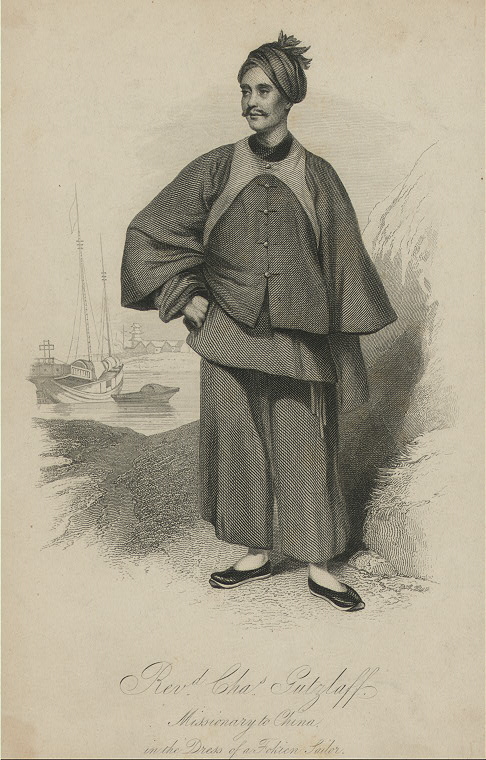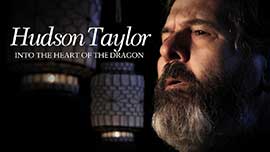THE DARING AND DISGRACE OF CARL GÜTZLAFF

[Above: Carl Gützlaff in Chinese sailor garb—public domain, Wikimedia File:Portrait of Chas. Gutzlaff (4672542).jpg]
WHEN THE SON OF GOD ministered on earth, one of his ministries was to heal the sick. The first Protestant missionaries to Siam (Thailand) also used medicine to gain entree into the Buddhist land.
On this day, 23 August 1828, Carl Gützlaff and Jacob Tomlin came to Bangkok. Tomlin recorded the scene:
The view of the city suddenly opened at two miles’ distance: the scenery and dwellings on either side became more varied and beautiful, as we advanced towards the capital. . . . There was a busy and lively scene on the river—innumerable boats and canoes passing to and from the city; a long line of junks, most of them laid up on the left side of the river; a little retired from the bank, Chinese smiths’ and carpenters’ shops; behind these, the Episcopal Romish Chapel, surrounded by glittering pagodas.
Gützlaff and Tomlin treated thousands of patients. They also distributed books and tracts, but these had limited value for native Siamese as they were written in Chinese. Gützlaff, however, had a gift for learning new languages, and in December 1829 he headed to Singapore to print a tract and one of the Gospels in Siamese. Tomlin had already left to recover his health.
Gützlaff’s translation was not the first attempt to convey the gospel in Siamese. Catholics had reached the nation in the seventeenth century but did not produce a printed literature. The first printed material was from the hand of Anne Judson, who had befriended Siamese women living in Rangoon, Burma (Myanmar). Studying their language for a year and a half, she translated a catechism, a brief introduction to Christianity, and the gospel of Matthew into Siamese. William Carey’s press in Serampore, India, printed this in 1819.
When Gützlaff returned from Singapore to Siam early in 1830, it was with Maria Newell as his wife. The two worked at translating the New Testament into Siamese and creating dictionaries of the Cambodian and Laotian languages.
One night a noise wakened Maria and she looked out the window: “The whole city of Bankok [sic] seemed to be one flame.” The wind blew the fire directly toward their home and they steeled themselves for the loss of all their possessions and work.
The wind continued unabated; and it appears to me like a miracle, that although the sparks from the immense masses of burning bamboo, wood and attap houses, were flying around us in every direction, not one fell upon our hut.
Maria died at childbirth in 1831. She left an inheritance which helped Gützlaff finance further work. Forlorn and longing to reach China for Christ, he left Siam, having served there barely three years. He made voyages along the coast of China in 1831, 1832, and 1833, traveling as far north as Korea.
Gützlaff served as an innovative missionary to China until his death in 1851 and helped translate the Bible into Chinese. Among his innovations was insistence on dressing in Chinese garb. He also saw the potential of employing Chinese evangelists to carry the gospel to their own people. Statistics he released for Bible distribution and Chinese conversions put traditional mission methods to shame.
Things were not as they seemed, however. Many of his agents were drug addicts who faked figures and sold Bibles back to Gützlaff’s publisher, who then resold them to him. When Gützlaff learned the truth, he allowed the false details to persist while he raised money for mission work. Other missionaries exposed his dishonesty.
Gützlaff also worked as an interpreter for ships dealing opium and for Western governments that abused China. Thus the memory of his Christian service is overshadowed by a cloud of disgrace. However, after his death the mission he founded—the Chinese Evangelisation Society—proved the value of his vision by bringing Hudson Taylor to China. Taylor’s achievements would far exceed anything Gützlaff attempted.
—Dan Graves
----- ----- -----
For more on Hudson Taylor, watch Hudson Taylor: Into the Heart of the Dragon at RedeemTV
(Hudson Taylor: Into the Heart of the Dragon can be purchased at Vision Video.)
For more about missions and the Chinese church, read Christian History #98, How the Church in China Survived and Thrived in the 20th Century








